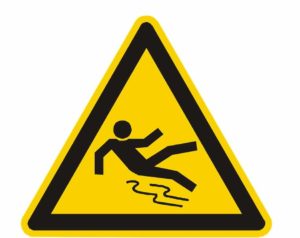Millions of people slip and fall in the United States every single year. While most of them are quickly on their feet again, more than 8 million are sent to the emergency department.
The Centers for Disease Control and Prevention (CDC) estimates that 1 in 5 falls results in a serious injury such as broken or fractured bones. Falls are also the leading cause of traumatic brain injuries.

Nearly 20% of all falls result in a severe injury.
If you were hurt in a trip or slip and fall accident, you may have grounds for a premises liability claim. Whether or not your claim has merit depends on whether your fall was caused by another person’s negligence.
Even if another person or company is in fact liable for your damages, there are steps you must take immediately after your fall to give your case the best chance of resulting in a fair settlement. Those steps are:
- Report the incident to the owner or manager of the property in writing, and ask for a copy of the report;
- Speak to people who witnessed your accident. Record what they saw, and write down their contact details;
- Take photos of the scene;
- Make detailed notes about how your accident occurred;
- Watch what you say – do not downplay your injuries or admit fault;
- See a doctor within 48 hours for a medical evaluation, and be sure to mention every part of your body that was injured so it can be properly documented; and
- Discuss your case with a slip and fall attorney.
Proving Liability in a Slip and Fall Injury Claim
You may feel that slipping and falling is no one’s fault but your own; however, if your fall was caused by a spilled beverage, a floor that was wet after mopping, a crack in the sidewalk, a concealed hole, a staircase that lacked proper lighting, or another hazard that was caused by someone else’s negligence, you can bring a claim for any damages that you incurred.
For your claim to be successful, you must prove that:
- A dangerous condition existed on the property;
- The property owner, manager, or staff knew about the dangerous condition or should have known about it; and
- They failed to remedy the hazard or to provide adequate warning to other people.
Besides the incident report and photos of the scene, your attorney may also rely on eyewitness testimony and surveillance footage of the accident to prove liability. After demonstrating that the defendant is responsible for your damages, your lawyer will then have to prove the value of your injury-related losses such as medical bills, lost income, reduced earning capacity, pain and suffering, and emotional distress.
Proving liability and the value of your damages can be complicated. You should expect the insurance company and/or defendant to look for reasons to dispute your claim. To avoid a liability or damages dispute, be sure to follow the tips listed in this blog, and do not hesitate to contact a lawyer if you sustained significant damages or if you anticipate a dispute.
